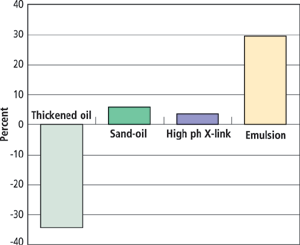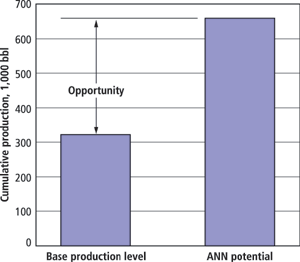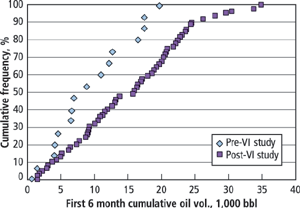Frac modifications identified through virtual intelligence increase production
Frac modifications identified through virtual intelligence increase productionNeural networks can show comparative results for completion and frac procedures that are not possible in the fieldDave Callison, Joe Jones * , Occidental of Elk Hills, Bakersfield, California; Bob Shelley, and Rusty Lockman, Halliburton Energy Services Occidental of Elk Hills, Inc. used Artificial Neural Network Modeling to identify changes that would improve the effectiveness of hydraulic fracturing treatments in its Western Shallow Oil Zone (WSOZ) completions at Elk Hills in California. Modeling demonstrated practices that would improve production. These include changes in pay selection and perforating practices, stimulation fluid type and volume, and breaker selection. Modeling demonstrates that altered completion / frac procedures could double production. Implementing these completion / stimulation changes resulted in an average completion value increase of $170,000 during the first six months of production. This article describes the modeling objectives and field validation that led to these successes. PROBLEM ADDRESSED Occidental operates about 400 WSOZ wells in Elk Hills field in Kern County, California. The company suspected that productivity and profitability could be improved by modifying its completion and stimulation procedures. However, before involving technical staff in a major study, Occidental wanted to quantify the upside potential and find what changes in completion / operational procedures were needed to realize that potential. The SOZ at Elk Hills covers over 20,000 acres across the 29R and 31S structures. Depths to productive intervals range from 2,000 to 4,000-ft subsurface. The SOZ is divided into two production entities, the eastern (ESOZ) and western (WSOZ). While the ESOZ occurs across the 31S structure, the WSOZ occurs on the west end of the 31S structure, across the 29R structure. Both production entities have different stratigraphic identities as well as distinct geographical distribution. The WSOZ is stratigraphically older than the ESOZ and comprises a series of shallow, marine-shelf (below wave base) deposits characterized as fine-grained, silty, clayey sandstones and siltstones that are highly bioturbated. The sandstones and siltstones exhibit high porosity (about 30%) and variable, but typically low, permeabilities (up to several hundred md in the best layers of some units, up to 10 md in others). The clays present within the sands are montmorillonites that are extremely sensitive towformation damage from fresh water. Clays and zeolites are also a concern because of possible fines-migration problems. APPLYING VIRTUAL INTELLIGENCE Occidental, with technology provided by Halliburton Energy Services, used Artificial Neural Network (ANN) modeling to evaluate readily available data. It was looking for trends that were not apparent and for ways to enhance profitability of its WSOZ completions at Elk Hills. ANN modeling identified key parameters without requiring extensive analysis by technical staff, saving scarce human resources. Specific objectives for the ANN modeling effort were to:
ANN MODEL DEVELOPMENT The WSOZ model was developed by back-propagation-training ANN modeling to predict a six-month cumulative oil production volume for completions. The ANN model developed from the Elk Hills data is a feed-forward type that can predict oil and oil-equivalent production for a well. The model-development data set comprised 24 wells, or records, with over 40 fields of data. Genetic algorithms were used to evaluate various combinations of input parameters and to select appropriate neural topology. Test data, comprising eight well records, was withheld from the training process to enhance and validate the ANN model’s generalization capability. The final ANN model consists of 16 input nodes, a single hidden layer with six neurons, and the output node. This model is capable of predicting a 12-month cumulative oil and oil-equivalent production volume with an R2 value greater than 0.90. This model requires the following information:
FACTORS INFLUENCING TREATMENT EFFECTIVENESS Several controllable completion factors were identified as high-impact parameters. Fig. 1 is a summary of sensitivities performed with different stimulation fluid types. The ANN model predicts that, generally, the greatest production volume would result from stimulation with a water-external emulsion-type fluid in combination with an encapsulated oxidizing breaker. Fig. 2 shows the results of sensitivities performed on stimulation treatment volume, proppant weight, treatment pump rate, and percent net-pay perforated. Larger stimulation volumes, higher treatment rates and selectivity in perforating were associated with greater production volume.
By studying the ANN model, the following guidelines for improving production were determined:
MODEL CONFIRMATION In the real world, no one can compare actual production rates from two different completion types on the same well. Even when re-stimulation of the same zone is performed, the well and reservoir conditions are altered by the initial completion. However, in the virtual reality of the ANN model, a comparison of production results can determine stimulation effectiveness. The ANN model can make production predictions using the same well and reservoir attributes along with the completion / fracture stimulation scenarios of interest. The predicted production for each completion type are noted and compared using wells from the database. Fig. 3 shows the production benefit estimated by the ANN model if the guidelines noted above had been followed in well completion. The ANN model predicts that an overall production increase of about 100% could have been achieved with more appropriate completion / frac procedures.
FIELD VALIDATION Fig. 4 shows the distribution of actual oil-production volumes for the Pre- and Post-VI study well groups. The median first-six-month cumulative oil production has increased from 7,830 bbl to 15,830 bbl. Additionally, the quality of low-end producers for the two well groups is about the same, but the post-integrated-modeling group contains significantly better high-end producers. The Pre-VI study is the production average from 16 well results, and the Post-VI study category is the average results from 60 wells. The average first six-month cumulative oil production increased 61% to 15,100 bbl. Additionally, the average six-month cumulative gas production increased 73% to 71.8 MMcf. The value of a WSOZ completion at Elk Hills has increased on average by $170,000 after six months of production compared to the average pre-study well.
The improved economics of WSOZ completions at Elk Hills has justified an accelerated development program. As of this writing, over 80 well completions have been performed using the guidelines established by the ANN model. This has resulted in creating over $12,000,000 of incremental value when compared to the results from previous completion methods. PTD REFERENCE Callison, D., Jones, J., Shelley, R. and R. Lockman, “Integrated modeling a field of wells, an evaluation of western shallow oil zone completion practices in the Elk Hills Field, Kern Co. CA,” paper SPE 76724, presented at the 2002 SPE/AAPG Western Regional Meeting, Anchorage, Alaska, May 20 – 22.
|
||||||||||||||||||||||||||||||||||||
- Shale technology: Bayesian variable pressure decline-curve analysis for shale gas wells (March 2024)
- Prices and governmental policies combine to stymie Canadian upstream growth (February 2024)
- U.S. producing gas wells increase despite low prices (February 2024)
- U.S. drilling: More of the same expected (February 2024)
- U.S. oil and natural gas production hits record highs (February 2024)
- U.S. upstream muddles along, with an eye toward 2024 (September 2023)
- Applying ultra-deep LWD resistivity technology successfully in a SAGD operation (May 2019)
- Adoption of wireless intelligent completions advances (May 2019)
- Majors double down as takeaway crunch eases (April 2019)
- What’s new in well logging and formation evaluation (April 2019)
- Qualification of a 20,000-psi subsea BOP: A collaborative approach (February 2019)
- ConocoPhillips’ Greg Leveille sees rapid trajectory of technical advancement continuing (February 2019)






